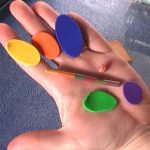Using Gold Polymer Clay as a Base for Mixing Custom Colors
Video #16: How to make mismatched clay colors look great together by mixing in a common base color to each one.
More...
IN THIS POST: — mixing colors — color recipes — gold — (Topics marked with an asterisk* are discussed in the Comments Section below).
Gold polymer clay is a great base color to use for mixing up custom colors that look great beside each other. It’s similar to mixing paint where the varying shades in a particular collection, all “work” nicely together because they all share a common base color.
So with polymer clay, if you have a bunch of different colors that don’t quite go together (or even if they clash) you can mix portions of the mismatched colors with your gold base clay. What you’ll end up with is a beautiful range of shades that all look like they were meant to be together. Don’t forget to write down your mix details in a recipe format for future reference.
This mixing technique will work with any neutral colored polymer clay such as white, black, grey, beige, pearl, silver, and of course gold.
In This “Making Colors Work Together” Video… Getting a group of somewhat mismatched colors to flow together is quite easy when you add a little of the same color to each. In this video you can see how I mix gold into a group of bright colors to get a shimmery batch of fall shades.
Transcript not available for this video.
Our goal is to translate these videos into as many languages as possible. If you are interested in helping with this initiative, then please do contact us and we will figure out a way to make it worth your while :)
Resource Links:
- Related Video: Color Plus 1 Polymer Clay Color Mixing Trick
- Related Video: Polymer Clay Color Mixing Color Saturation
- Related Video: Understanding Polymer Clay Color by Making Mud
- Related Video: Learning About Polymer Clay Color Mixing Maggie Maggio Style
- Related Video: How To Mix Polymer Clay Tutor Color Recipes
- Amazon: Geometric Shapes Cutters in Graduated Sizes **
Resources marked with a double ** asterisk are affiliate links. If you click on them and decide to buy something, we may receive some compensation. This does not affect the price you pay in any way. What it does do, however, is helps us to continue providing free videos for you, here at the PcT website. Using our links to purchase your tools and supplies, is always greatly appreciated.
Sponsored Ads & Special Promotions

To share this full blog post anywhere on the web that allows links in comments, here's a shortened url to copy and paste...
>> https://mypct.ca/v16 <<

Want to chat about today’s post? That’s what the comment section below is for. Scroll Down… We’d love to hear from you!
Or... if you would like to request a topic for a future post, here is the link to do that… PcT Suggestion Box

That is fantastic Karen! I am so glad you liked the idea. Copper is such a nice rich color, I bet your colors turned out great! Thanks for the comment!
This tip is fantastic! I purchased a couple of Fimo multiple color packs that were on clearance sale. I found there were colors in the package that I normally wouldn’t use straight out of the package, such as a bright magenta and a bright green. However, when I mixed those colors 4:1 with copper, I got a lovely deep rose color as well as an olive green color that went perfectly with the rose color! I had to keep experimenting, so I ended up with several nice colors that go well together. Thank you!!
Thanks for your question Paula!
I have used gel pens before but it can be tricky to get them to write on the clay. Metallic pens work, as well as permanent pens like Sharpie.
Hope that helps!
Hi Cindy, I am working with cured sculpey and am trying to use pens/markers to add detail. I am using Painty pens and they bleed and I’m not happy with them. What type of paint do you recommend to color/paint on cured clay?
Thanks Pepper! Sometimes the simplest ideas are the best ideas!
Cindy Lietz’s last blog post..A Polymer Clay How To Tip for Making Beads Using White Fimo Clay
Of all the books I’ve bought and read on pc, NONE of them gave this helpful hint! Woohoo..way to go Cindy!!!
You can get a similar effect by mixing any color to each of the polymer clay colors you happen to be working with. Pearl and silver work very similar to gold, so give them a try too.
Remember that any three primary colors will give you a brown, so adding a red to a green may become muddy depending on the amounts added.
Cindy Lietz’s last blog post..Polymer Clay Lentil Beads – Making Them Can Be Very Addictive!